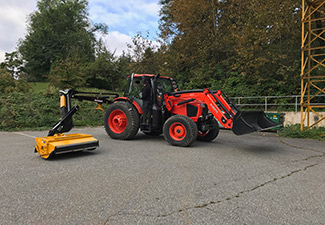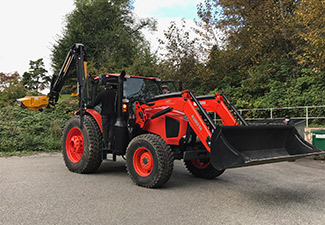
Blackberries, meet flail-mower: Riverview welcomes a new tool
The blackberry bushes on the Riverview Lands have a new nemesis. It’s called a flail-mower, and it arrived on October 14. Our whole team is celebrating this long-term investment from BC Housing into the care of the Riverview Lands. Our Grounds Crew, specifically, are pleased to announce that they will no longer be tackling several rapidly growing plants by hand.
While blackberries are delicious in August, they are selfish neighbours year-round. They grow more quickly than most native plants, and they hoard light and soil nutrients wherever they go. According to a 2019 report assembled by Metro Vancouver and the Invasive Species Council of BC, the presence of Himalayan Blackberry in a given area is associated with decreased biodiversity overall. While the plants do provide some cover and food for birds, they’re not as beneficial for the surrounding environment as their native alternatives. The flail-mower won’t be a solution for all invasive plants – some, like knotweed, require more specialized removal – but we’re excited to protect the Riverview Lands’ rich biodiversity with a new strategy for non-native brambles.
Himalayan Blackberry likes areas that have been previously disturbed; since the Riverview Lands were clear-cut and regraded in the early 20th century, the site is an attractive place for blackberries to spread. Blackberries use multiple strategies for reproducing – a daughter plant can sprout any time a first-year cane touches the soil. Underground runners can extend up to 10 metres from a plant, producing shoots along the way. A thicket of blackberries can also produce 13,000 seeds per square metre, and these get dispersed by birds and other animals. Seeds can remain viable for several years, meaning that if weather is unfavourable one year, seeds can simply wait it out. While blackberry plants do best in fertile soil with ample drainage, they’ll take up residence just about anywhere: along roads, wetlands, watercourses and forested areas, for example. They’re notorious for out-pacing pruning efforts in the summer months and pruning without a specialized machine is tough work. Our Grounds Crew are looking forward to giving their sheers a rest.
That’s not to say that the flail-mower is used exclusively for invasives. It can be used to cut grass, trim hedges and even remove snow. It has a loading bucket on the front, and an arm which can extend 20 feet in any direction, meaning it can be used around roadways and signage. Unlike with a traditional mower or a rotary cutter, flail-mowers can cut lawns down to a quarter of an inch (as opposed to ¾ of an inch or one inch even). This leaves lawns looking ultra-manicured. Where it really shines, however, is in disposing debris. A flail-mower uses between 90 and 120 different rotating blades to grind roots, shoots and brambles up to a pulp. This means it won’t leave material behind that could re-root.
Our Grounds Crew received their first round of training to use the machine on October 15. We’ll be sticking to low-traffic locations until the staff are fully comfortable using the flail mower. If you’ve noticed that the area around the Oak Crescent cottages is looking particularly polished, you can credit our fancy new technology (and, of course, its human operator).


